The Pistachio Scope
The latest offering from Damghan University's Pistachio Innovation Center, The Pistachio Scope is a series of essays dedicated to providing insight into Iran's pistachio industry, its historical background, and - perhaps most importantly - the sociological and cultural impact of this product on the nation. The essays offered here are aimed to be as informative as possible while maintaining to be concise. In order to view each article, click on the right side-panel. On top of each page, you will find a link to download the article to your device.
- Pistachio in Iran - A Brief Historical Overview
- The Industry
- The Edible Byproducts
- Non-Edible Byproducts
- Deep Roots in Language
- Cultural Significance of the Persian Pistachio
- The Socio-Economic Implications of Pistachio Production
- Damghan’s Unique Pistachios: Kaleh Ghuchi
- Damghan’s Unique Pistachios: Khanjari
- Damghan’s Unique Pistachios: Akbari
- Damghan’s Unique Pistachios: Ahmad Aghaii
- Damghan’s Unique Pistachios: Shah Pasand
Today, pistachios are grown in many cities and villages on the outskirts of the desert, especially in the eastern and southeastern regions of the country, the most significant of which are Damghan, Kerman, and Rafsanjan. Among all of the pistachio-growing regions in Iran, the products of Damghan, Kerman, Rafsanjan, and Sirjan are known as having a much higher quality compared to others. Moreover, historical evidence has demonstrated that the aforementioned cities host some of the oldest pistachio trees in the country – going up to 400 years old. Yazd and Ardakan pistachios are also noted in historical documents, especially for their rigidity in saline and dry conditions.
Iranian pistachios come in many varieties, among which are Arbar Aghaee, Kalleh Ghouchi, and Khanjari, particularly known for their superior quality. Particular to the region of Damghan is Kalleh Ghouchi, which happens to have the most dense nut and is mostly associated with exceptional taste. Badami pistachios, also known as Ahmad Aghaei pistachios with their colorful kernels and white shells are also native to the Damghan and Ardakan regions. Moreover, Abbas Ali pistachios are among the most famous famous products of Damghan.
Statistics have shown that the pistachio orchards in Iran have an extremely alternate bearing behavior with the pistachio trees bearing a dense cover of fruit in one year, and being almost devoid of any pistachios the next. The alternate bearing habit of the pistachio trees is known in some areas locally as "bozghanj" (in Persian: بُزْغَنْج). Traditionally, pistachio used to be sold with the hard shell and without any additives, as the shell would keep the fruit fresh for a long time after the harvest. There were markets where peeled and roasted pistachio nuts were sold. However, due to the loss of original flavor, these products normally had a comparatively limited market. To counter this issue, some of the sellers would preserve the peeled nuts from spoiling by soaking them in vinegar.
Pistachio trees, especially the variants traditionally grown in Iran, are known as extremely resilient plants. Pistachios are among the few crops that do not require much water and are resistant to soil salinity. Therefore, many of the pistachio-rich regions in Iran are located near the desert edge. One of the methods of cultivating pistachios in the Damghan and Yazd regions was reportedly to plant pistachios with split shells by wrapping them in cotton and putting them in the soil. In this method, the nut was put into the soil with the split side facing upwards.
Over time, pistachio nurseries became commonplace – primarily in Kerman and Semnan provinces – that would soak pistachio seeds and plant them in black plastic bags filled with soil. Moreover, the watering schemes have changed widely with most of the farmers adopting drip irrigation systems to water the plants in a timely manner, allowing the young plants to develop roots, stems, and leaves. These seedlings are planted in suitable intervals in the winter season, and they are watered once a week. Although the practice of directly planting pistachio seeds in the ground still exists today in Iran, many farmers choose to purchase seedlings from nurseries for improved performance on large-scale operations. The rest of the process is standard and similar to the approaches used currently in the American pistachio industry: after two years, when the pistachio sapling becomes well-branched and strong, the farmers graft a branch from an older, desired pistachio variety onto it using appropriate budding methods to produce new branches.
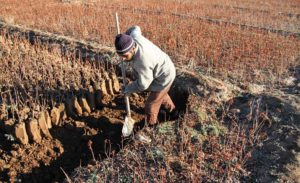
A Pistachio Nursery in Sirjan, Kerman Province
A traditional approach in cultivating pistachios in Iran was to graft desirable, high-yield varieties onto wild pistachio trees known locally as ‘baneh’(In Persian: بَنِه, a.k.a. Pistacia vera). Although the result was usually a very low-yield tree with small-sized fruits, the nuts were noted by the locals as being very delicious and of high quality. These grafted pistachio trees started bearing fruit after 4 years and could continue to do so for up to 35-40 years. Grafters were paid based on the number of grafts they made. In many of the local communities in the pistachio-rich regions, the people believed that pistachios and almonds were ‘friends’, and by planting them close to each other they would yield more.
In Sirjan (Kerman province), the harvesting of pistachio locally referred to as ‘Sabzpesteh’ (سبزپسته) usually began in late September and continued until late November, which was known as the month of ‘pistachio cleaning’ (پستهپاککنی). In the past, pistachio orchard owners would go to their orchards a few days before the start of the harvest. Many of the large-scale pistachio producers would settle in small, brick-walled cottages located in the orchard known as ‘sofe’ (صُفه) to begin the shaking of the pistachio trees. Depending on the need for manpower, men, women, and children celled ‘pistachio cleaners’ (پسته پاککن) would show up, and start the process of harvesting under the guidance of a supervisor (in Persian: سرکارگر). Children, who were lighter and could easily climb trees were employed to pick pistachios from the branches of older trees. Women participated in collecting clusters and shaking pistachio nuts off them, while men, in addition to picking, were responsible for transporting pistachio loads.
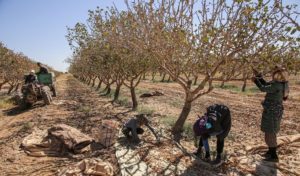
Pistachio Harvest in Damghan, Semnan Province
According to the Royal Botanic Gardens of Pew and Plants of the World encyclopedia, Pistachio belongs to the cashew family originating mainly from the plateau of Iran, Afghanistan, and Central Asia. Moreover, various sources including French writers and encyclopedias like Britannica and Americana, have different opinions on the birthplace of pistachios, suggesting regions such as Iran, Arabia, Syria, and more.
Pistachios, classified as tropical fruit, were termed "anacardiacae" by Linnaeus from Spain in 1737. Unlike almonds and walnuts, the pistachio tree is dicotyledonous, with separate male and female trees. The pistachio tree bears a bountiful harvest one year and a less abundant one the following year. The etymology of pistachios dates back 4,000 years in Iran. The word "pistachio" has traversed languages like Greek, Latin, European, Arabic, Turkish, Russian, Japanese, and more from its Persian roots. When pistachios first found their way to Iran, they were known as "Pistaco" in Persian, later evolving into "pistachio." The Latin term "pistachio" is derived from this word. Since then, pistachio orchards have flourished across Iran. The Persian term "pistachio" has been traced to the inhabitants of northern regions in Kerman. The word "pistachio" itself is a deeply ancient Iranian word, stemming from the local dialect spoken in the pistachio-rich territories of Kerman province.
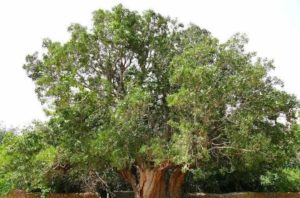
Iran’s oldest pistachio tree in Rafsanjan, at 15 meters high with a diameter of 3.5 meters
Wild pistachio forests in the northeastern regions of Iran and areas bordering Turkmenistan and Afghanistan have ancient origins. The pistachio tree is believed to have become domesticated in Iran around 4,000 to 3,000 years ago, with Sabzevar and Sarakhs considered among the oldest cultivated areas. The history of pistachio cultivation in Damghan, Semnan, and Qazvin is attributed to the 7th century AH (13th century CE), while it dates back to the 12th century AH (18th century CE) in Kerman province. Despite Iran's long history of pistachio cultivation, pistachio farming has experienced significant growth in recent decades.
The Iranians were the first to transplant this type of nut from its natural habitat, the pistachio forests scattered in the northeastern mountains of Iran, to the plains. Gradually, they spread it to other regions of the Iranian plateau. During this expansion, qualitative development has also occurred. They aimed for larger, plump pistachios with desirable characteristics like the greenness of the kernel and the whiteness of the shell, making them more productive.
The roots of pistachio cultivation in Iran stretch back to the Achaemenid era, approximately 4,000 to 5,000 years ago. It is believed that the natural pistachio forests and trees in Iran were tamed and cultivated some 3 to 4 thousand years ago. From there, they spread beyond Iran's borders, especially to regions around the Mediterranean Sea.
The initial emergence of pistachios can be traced to the Achaemenid period and the Kerman regions. Following the rise of Islam, Qom gained prominence as a pivotal area for pistachio growth in Iran. Its historical origins date back to the early centuries AH, while the earliest writings about pistachios in Damghan, Semnan, and Qazvin are attributed to the seventh century, and pistachio cultivation in Kerman began in the twelfth century. Presently, Iranian pistachios are named after the regions where they have historical roots, were transported from, and are produced, such as Damghani, Qazvini, Ravari, Sabzevari, and Qomi pistachios. Additionally, it's worth noting that pistachios are categorized by their shapes. Varieties like Mumtaz (smiling), Baluchi, Koleghoochi, white pistachio, green pistachio, and dagger have distinct ripening times, falling into early and late categories, maturing from late August to early October.
As pistachio cultivation expanded to different regions and lands, various varieties were chosen based on the climatic differences of each area and the preferences of the orchard owners in selecting pistachio cultivars. Over time, a series of pistachio varieties were selected in each region, tailored to that region's characteristics and the preferences of its people. In Damghan, for example, they selected large pistachios with tender, delicious kernels, and a green color, influenced by the region's dry and warm climate.
The introduction of pistachio to the United States goes back to 1854 through Middle Eastern immigrants. However, the acreages were limited to small patches of land in California, and serious attempts at cultivating pistachio in America didn’t start until 1920, at which point an American botanist called William E. Whitehouse traveled to Iran for a year. He brought back certain cultivars from Iran, among which was the female “Kerman” cultivar. Kerman became the subject of multiple experiments over decades until it became a staple of the American pistachio industry in the late 1980s.

William E. Whitehouse, the USDA researcher who experimented for decades on the “Kerman” pistachio female cultivar
The ancient pistachio trees found in the Damghan region, some of which have been grafted and cultivated, indicate that grafting techniques were introduced by the people of Damghan and incorporated into pistachio cultivation methods. Old pistachio trees in other ancient regions either haven't been grafted or don't show the grafting effect on their old trunks. This technique contributed to asexual propagation and the development of uniform and high-quality varieties.
Due to its favorable geographical location, Damghan benefits from being located in the three major provinces of Iran, including Tehran, Mashhad, and Isfahan. Major varieties of pistachio produced in Damghan are Fakhri, Abasali, Khanjari, and Shahpasand, and are known for producing early-harvest pistachios. Furthermore, its proximity to consumption markets, primarily Tehran, provides opportunities for direct sales for Damghan's orchard owners.
As one of the world's largest pistachio producers, Iran's pistachio industry has the potential to significantly boost its income by tapping into the value of its edible byproducts. Here we introduce two of these byproducts – namely virgin pistachio oil and pistachio butter - that offer a unique opportunity to diversify revenue streams and promote sustainability within the pistachio sector.
Virgin Pistachio Oil: A Nutrient-Rich Elixir
Virgin pistachio oil, extracted from the nut's meat through mechanical pressing, holds remarkable nutritional and culinary properties. The oil's vibrant green color, reminiscent of the pistachio itself, signifies its natural goodness. The organoleptic characteristics, including aroma and taste, capture the essence of pistachios in a concentrated form.
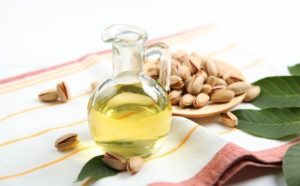
Beyond its culinary applications, virgin pistachio oil brings with it the potential for significant economic benefits. By promoting its unrefined and virgin state, Iran can position itself as a producer of premium pistachio oil with a high smoke point—a desirable attribute for various cooking methods. This premium status, when combined with effective marketing strategies, can command higher prices in both domestic and international markets.
Pistachio Butter: A Creamy Delight
Pistachio butter, another valuable edible byproduct, is created by blending ground pistachio nuts with sugar and permissible additives. This luxurious spread embodies the richness and flavor of pistachios while offering a unique texture that distinguishes it from traditional pistachios. Just like pistachio oil, pistachio butter is an excellent source of nutrition, providing a balanced profile of healthy fats, protein, and antioxidants.
The allure of pistachio butter extends beyond its taste and nutritional content. It can be used as a versatile ingredient in various food products, from spreads to desserts, enhancing their flavor and nutritional value. By capitalizing on this versatile ingredient, the pistachio industry can create a diverse range of products that cater to different consumer preferences and market segments.
The utilization of edible byproducts aligns with the principles of sustainability and circular economy, adding value to every part of the pistachio nut. By optimizing the production of pistachio oil and butter, the industry can minimize waste and maximize returns on investment. This approach not only increases revenue but also reduces the environmental impact of pistachio processing.
The global demand for healthy and gourmet foods continues to grow, offering Iran's pistachio industry a golden opportunity to expand its reach. The uniqueness of virgin pistachio oil and pistachio butter, with their authentic pistachio flavor and nutritional benefits, can set Iran's products apart in a crowded marketplace. Effective branding and marketing campaigns can position these byproducts as premium options for health-conscious consumers and culinary enthusiasts around the world.

Iran's pistachio industry possesses the immense potential to enhance its income by leveraging the edible byproducts of pistachios. Virgin pistachio oil and pistachio butter offer not only nutritional value but also economic viability. By focusing on sustainable practices, market differentiation, and international competitiveness, Iran can harness the power of these byproducts to bolster its pistachio industry income. As the global appetite for healthy and gourmet foods grows, the time is ripe for Iran to elevate its pistachio industry to new heights and secure its place as a leader in the international market.
Challenges stemming from raw pistachio exports in Iran have led to the inclination toward producing secondary products from this commodity to maintain the industry’s sustainability over the coming years. Currently, about 2% of the entire pistachio production in Iran is processed annually, and the remaining majority of the product is being supplied domestically and exported in its raw form. As a result, the bulk of pistachio production does not yield added value despite the potential.
Meanwhile, foreign countries purchasing Iranian pistachios have employed various methods to turn them into significantly higher-profit products. Therefore, there is a need for publishing guidelines and relevant content to inform the industry’s stakeholders about different ideas and methods for producing value-added products. This can significantly impact the expansion and diversification of agricultural processing industries in Iran, considering the recent challenges with the export of raw pistachios. Each year, substantial quantities low quality pistachios are produced in various processing stages. Since these products cannot be directly marketed as nut products, they result in capital loss to the farmer.
Pistachio Compost
Pistachio Compost is a byproduct resulting from the cleaning of pistachios. It includes soft outer skins, clusters, leaves, stems, and hollow or “blank” pistachios. With its production at about 1.6 times that of produced dried pistachios, this byproduct possesses suitable nutritional value and can be used as a part of the diet for livestock and animals.

Packaged pistachio compost used as livestock feed
The presence of arid and semi-arid climates in most regions of the country, limitations in pasturelands, scarcity of accessible water resources, low rainfall combined with inappropriate precipitation patterns, and mismanagement of available resources have led to a shortage of usable feed resources for livestock.
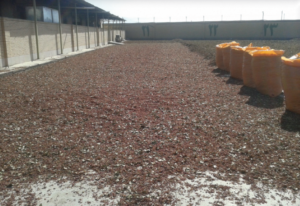
Pistachio waste in the drying process to eliminate fungi growth
On the other hand, a significant volume of various agricultural byproducts with potential use in animal diets is produced annually in Iran. Among these, pistachio byproducts and waste are among the most important agricultural byproducts, estimated at around 5 to 8 hundred thousand tons annually in the country. Research results indicate that this byproduct holds appropriate nutritional value and can be utilized in animal diets. Utilizing this byproduct in pistachio-rich regions of Damghan and Rafsanjan, being situated in the warm, dry, and desert areas of the country, can help alleviate feed shortages.
In addition to addressing feed shortages for livestock in the country, the use of this byproduct can contribute to reducing environmental pollution and mitigating the proliferation of Aspergillus fungi in pistachio orchards. The high moisture content and suitable organic material in pistachio waste create favorable conditions for rapid decay, necessitating special attention for the storage and preservation of pistachio compost. Natural drying of the compost requires a minimum of 4 days in a clean space with multiple turnovers during the day.
With appropriate processing, pistachio byproduct can be mixed in the diet of dairy cows up to 8%, beef cattle up to 12%, and sheep and goats up to 20%.
Producing Soap from Pistachio Oil Waste
Pistachio kernels of all quality degrees contain a high amount of oil (approximately 45%) which can be extracted relatively easily. Utilizing this oil in producing a value-added product such as soap can not only prevent economic loss but also lead to a final product with unique selling points. Moreover, due to the essential role of soap in personal hygiene and the increasing demand for various types of soaps with diverse functions, incorporating soap products and their production into practical and suitable commodities deserves significant attention.
Pistachio oil contains carotenoids, chlorophyll, and vitamin E, substances that contain significant amounts of beneficial unsaturated fatty acids. It also contains biologically active components such as phenolic and polyphenolic compounds that, in addition to nutritional value, contribute to its noteworthy antioxidant. Due to its high skin penetration, rapid skin absorption, softening, moisturizing, reparative, and soothing properties, as well as a significant percentage of absorbable organic and mineral substances, pistachio oil is considered a suitable option for use in cosmetic and personal care products. In addition to pistachio oil, other ingredients – including animal fat – can be used in the production of soap to enhance the product quality.
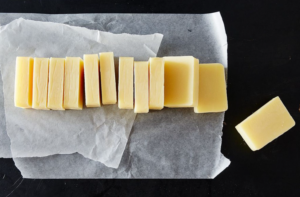
Soap produced using pistachio oil before packaging
The most common oils used in soap-making fall into two groups: oils from plant seeds (like coconut oil and palm kernel oil) and hard oils (such as animal fats and palm oil), both of which are required for producing suitable soap. Therefore, besides pistachio oil, materials like tallow and coconut oil, along with other additives that contribute to product quality can be used.
Iranian scholars have had various opinions regarding the origin and etymology of the word pistachio (پسته) in the Persian language. For instance, the renowned poet Malek osh-Sho'arā Bahār suggested that the word pistachio was borrowed from Greek and Roman languages into Persian. Mohammad Moein, the Iranian literary scholar traced the origin and root of the word pistachio in the Arabic word ‘fastaq’ (فستق), the Aramaic word ‘pestaga’ (فستقا), and the Greek word ‘pistakion’ (πιστάκιον). Moein believed that the word first originated in Syria, transferred to Greek, and spread to other European languages. On the other hand, Abu al-Qasim Soltani, the Iranian planetologist pointed out that the word ‘bastaqia’ (بسطاقیا) in Dioscorides' book was derived from the word ‘bistak’ (پیستک) or ‘bestaga’ (بستقا) in Persian literature.
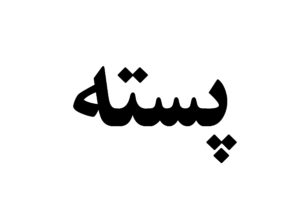
Ebrahim Poordavud, the Iranian historian claimed that the word ‘pistachio’ (پسته) has been borrowed from Persian into European languages. According to Western sources, during the Crusades in the 12th century, Crusaders returning from Syria brought back sugar along with other products, including pistachios, saffron, and sesame, which introduced these words to Europe. Parviz Natel Khanlari, the Iranian linguist asserted that pistachio trees are native to northern Khorasan, particularly the region of Saghd, and the word ‘pistachio’ spread from there to other regions. It should be noted that this theory was also held to be true by Barto Laufer, an American Iranologist who also emphasized the significance of pistachio trees, especially the Pistacia vera (known in Persian as بنه کوهی) in ancient Saghd and Khorasan.
Linguistic evidence shows the pronunciation of the word ‘pistachio’ to have deviated from its original pronunciation toward the end of the Sassanid era in regions beyond the Oxus River in present-day Central Asia. For instance, in the city of Bukhara, around 37 AH (Islamic calendar), there was a well-known market called the ‘Pesteh Shekanan Bazaar’. This suggests that the terms bazaar (بازار) and Pesteh (پسته) were already in use in the modern sense. Furthermore, the pistachio crop in the forests and mountainous regions beyond the river and around Bukhara was abundant to the extent that a market was established in Bukhara to shell the pistachios produced in those regions.
Furthermore, the word ‘pistachio’ is a very ancient Iranian term whose origin and roots should be sought in the first habitat of these trees. Therefore, the word has its origins in the dialect of the people residing in the extensive pistachio-rich region of Khorasan which, in ancient times, covered a vast geographical area. This extensive region encompassed thriving cities and major pistachio-producing areas of ancient Khorasan, such as Balkh, Herat, Marv, and Nishapur, as well as the areas beyond the river, including cities like Bukhara, Samarkand, and many others. In fact, the Iranian word ‘pistachio’ (پسته) found its way from this region to other parts of the Iranian cultural sphere and the sphere of Persian language influence and was introduced to other nations and cultures around the world.
Perhaps one of the oldest statements on the origins of the word comes from Abu Mansur al-Tha'labi al-Harawi, a great Iranian scholar and Arabic lexicographer who was known for his comprehensive knowledge of Persian vocabulary and its integration into Arabic. It has been that Aburayhan Biruni, who was himself from a pistachio-producing region, quoted al-Tha'labi as saying that the Arabic word of ‘fastaq’ (فستق) is an Arabicized form of the Persian word ‘pesteh’. This reinforces the idea that the word has deep roots in Iranian culture and geography
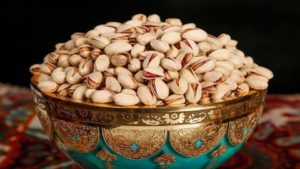
The word ‘pisteh’ (پیسته) belongs to the dialect of the people of ancient Khorasan, which is still the term used in some regions of Khorasan such as Torbat Heydarieh, Javanrud, Khaf, Sabzevar, and Nishapur, as well as in many areas of Afghanistan, Tajikistan, and among Persian speakers in Central Asia. In the Lasgardi and Sarukhi dialects (from the Semnan region), the word pistachio is pronounced as ‘pestak’ (پستک) and ‘pesteka’ (پستکا). In particular, the word ‘pesteka’ phonetically resembles the ancient Persian word ‘pistaka’, which was in use during the time of the Achaemenids.
Linguistic evidence also shows that the pronunciation of the word ‘pistachio’ in various regions of Sarakhs, Zoroabad, Javanrud, Damghan, and Badghis has been a byproduct of the sound of breaking open the hard shell of wild pistachios (hence the pronunciations of ‘pisteh’ (پيسته), ‘pestak’ (پیستک), and ‘pestak’ (پستک)). Therefore, it is strongly believed that the Persian word ‘pesteh’ has a phonetic origin. In other words, the sound of breaking open the pistachio shells became the onomatopoeic name for this fruit.
Today, the pronunciation of the word varies somewhat in contemporary dialects. For instance, the word is pronounced in Yazd province as ‘pestah’ (پستَه) and in the province’s Kalameyi dialect it is pronounced as ‘pesso’ (پسو) and ‘fessok’ (فسوک). In the Tat dialect of the Qazvin region, it is pronounced variably as ‘pestiah’ (پستیا) and ‘pesse’ (پسه). In the region of Delijan, it is pronounced as ‘pesdonae’ (پسدون), and in the Khansari, Borujerdi, and Shushtari dialects it is pronounced as ‘pessa’ (پسه). Lastly, in the Azerbaijani dialect, it is pronounced as ‘pusta’ (پوسته).
Although no hard historical evidence has been observed, it is reported that Romans and Greeks learned the method of pistachio farming and irrigation at the time of the Achaemenids, which was known at the time as Persian ‘walnuts’. Upon the visit of the Romans and Greeks, Parthians were observed to habituate their children to eat the fruits of wild trees including pistachios. In fact, the consumption of pistachios in Pars to the extent that the Greeks ridiculed and taunted the Persians as ‘Pistachio eaters’.
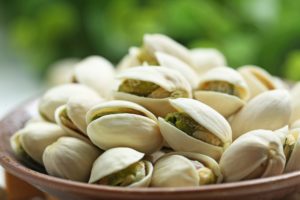
In their reports, travel writers have mentioned the cultivation of various pistachio trees in the geographical expanse of Iran and the cultivation of various pistachio species in pistachio-rich regions. In particular, a number of travel writers have spoken of the fertility of the regions including Damghan, Kerman, and Qazvin region for the abundance and quality of its pistachios.
During the Safavid period (1500-1723 AD), they considered Malayer pistachios to be the best in the world, where in addition to domestic consumption, a large quantity of it was exported to India. In the Qajar period (1892-1926 AD), there are also references to the export of pistachios to India when the pistachio product of Isfahan was one of the important export items of this city.
Pietro Della Valle, the Italian historian mentioned pistachios to be used as a primary condiment commonly eaten with rice in his observations in Iran. Jean-Baptiste Tavernier, the French merchant also mentioned Armenians in Isfahan who, during fasting days when they were not allowed to eat animal produce, crushed pistachio nuts and mixed the obtained oil with their food. In the report of Sir John Chardin's travels to Iran during the Qajar period, pistachios were mentioned as one of the dried fruits that were present in the banquets of the Iranians (p. 50). Apparently, during the Qajar period, pistachios were always considered luxurious snacks for the nobility and kings. For instance, the combination of pistachios and high-fat yogurt was one of the popular snacks prepared for Naser al-Din Shah. In all of these reports then, pistachio kernels were one of the staples of the Persian dishes.
In the historical reports, the initial tools for the harvest of pistachios in pistachio-rich regions were two large pieces of thick and stringy fabric. In the process of harvesting, the workers took these fabrics to the orchard, spread the fabric under the trees, and then poured the hand-picked pistachios into it. Then, men known as ‘kooleh kon’ (i.e. carriers, in Persian: کولهکُن) would carry the gathered pistachios on their backs and transport them to an open field for hulling and cleaning. If the distance between the pistachio cleaning area and the harvest area was too long, the workers would put the loads on the backs of animals. The pistachios were poured into a small courtyard surrounded by half-walls called ‘kooch’ (کوچ) which means a corner or nook.
In Anar County in Kerman province, people used short, thick wooden sticks called ‘kootino’ (In Persian: کوتینو) to strike the pistachio branches so that the soft outer shell of the pistachio separated from the wooden shell. The task of cracking the non-split shells of the pistachios was also assigned to women and teenagers who would open the shells with their hands or pliers. Then, the pistachios with separated shells were poured into boxes with a wooden ‘plaque’ bearing the name of the orchard owner. These boxes were referred to as ‘nomreh’ (in Persian: نُمره), and the workers would receive a fixed amount of money for each ‘nomreh’ they handed over.
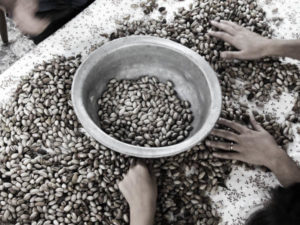
Pistachio Sorting Mostly Done by Hand at the Orchard
Due to the luxurious nature of pistachios and their high price, strict rules were enforced on the workers who removed the hulls of the pistachios. These rules were so strict that during the cleaning process, orchard owners would check the workers several times lest they would eat any pistachios. If they witnessed such an incident, a fine would be imposed on the worker, and if they suspected and the worker denied it, they would put a cotton ball in the worker's mouth. If the ball turned green, it indicated that the worker had consumed pistachio and ensued physical punishment. In addition to this, at the end of the working day when the workers were leaving, they would also check their shoes to make sure they hadn't stealthily taken any pistachios with them. If they detected any theft or cheating, they would physically punish the workers.
Female workers – who were situated in a separate area – would separate the shells from the pistachios and clean them. In Sirjan, the workers would wash the cleaned pistachios in oval-shaped pottery containers called 'javieh' (in Persian: جاویه), then spread them on large screens called 'parse' (in Persian: پَرسه) placed on pistachio cleaning platforms to dry in the sun. Pistachios that were not separated from their shells in the process were called 'kalo' (in Persian: کَلو) and those with removed shells were called 'laqo' (in Persian: لَقو). Pistachios that could be separated from their shells without the need for washing were called 'pesteh-dastpoost', and were considered to be the best and most desirable type. Pistachios selected for planting were called 'pesteh-tokhmi' (i.e. seeds).
Finally, The workers would often be placed into groups by the supervisors to delegate the work, and whoever had the most work done in this pact would receive additional pay or a reward. Worker wages were paid based on the amount of work completed. Some employers also provided pistachios to the workers in addition to their wages as rewards.
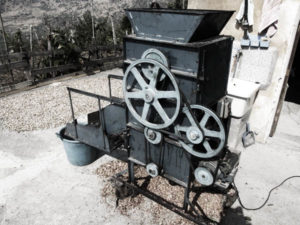
Small-Scale Pistachio Cleaning and Dehulling Device
As previously mentioned in other articles published in the “Pistachio Scope”, the city of Damghan in Semnan province is considered a fertile ground for high-quality pistachio production. Apart from the strategic importance of pistachio production in Damghan, numerous social, cultural, and economic factors have had an impact on the city and its residents. It should be mentioned that despite these changes, the potential for pistachio production has not been fully realized in Damghan due to a lack of attention to the economic and social characteristics of pistachio farmers, which may include: the use of tools, adoption of modern methods, investment levels, age, education, cultivation history, knowledge, and professional skills related to pistachio cultivation. However, these factors – albeit limited in scope – have already influenced the economic and social aspects of pistachio cultivation in rural households in the region.

The pistachio production in Iran, according to the Agricultural Statistics Yearbook for the agricultural year 2013, accounts for approximately 1% of the total agricultural production and ranks fifth in the country. In Semnan province, the detailed results of the General Agricultural Census in 2011 showed that Damghan County was the leading producer of pistachios, with 3,279 tons of pistachio production out of a total production of 4,636 tons in the province. Pistachios are primarily cultivated in the eastern part of Damghan County, especially in the Daman Kouh district, which had 939 hectares of pistachio cultivation and produced 962 tons of pistachios in the same year.
Given the high economic value and profitability of pistachios, as well as the ecological conditions suitable for pistachio cultivation, and the potential economic and social impacts of both small and large-scale pistachio farming, it is not unexpected to see major economic, social, and cultural effects within pistachio-producing households. Moreover, as we see later in the present article, there is even a relationship between the lifestyle of the households and the production of pistachios.
A study was conducted in 2015 to study the socioeconomic effects of pistachio production on households. In the aforementioned study, several pistachio-producing households both within the city of Damghan and the rural regions participated in a survey regarding their lifestyle choices, economic aspects of their livelihood, and the cultural changes made in their daily lives.
Unsurprisingly, the answers showed a significant direct relationship between the experience and years of pistachio cultivation within the household, and variables such as housing type, housing area, food consumption, economic security, education and knowledge, and professional skills, indicating that the higher number of years spent in the pistachio industry would lead to an increase in these variables.
The agricultural practices along with the significance of the pistachio as a valuable crop, then, have had measurable changes in the lifestyle of households in Damghan city. The availability of funds for education, accumulation of high-quality consumer goods, and better housing have changed the overall outlook of these households.
The size of the operation is also directly related to various factors and lifestyle choices in pistachio-producing households. The households who own more acres of pistachio-bearing land are also the ones with better types of housing with higher quality, more vehicle ownership, ownership of durable consumer goods, higher chances of employment, participation in more expensive leisure activities, have a higher number of annual trips, utilizing better educational services, and finally acquiring more knowledge and professional skills.
Moreover, since higher levels of investment in the operation would result in better crop yield, the return on investment would also result in a higher quality of consumer goods chosen by pistachio-producing households. In this study, it was revealed that more successful pistachio growers in Damghan are the ones who maintain an annual investment budget for better equipment and workforce. Conversely, growers with lower levels of investment usually have lower crop yields, which in turn results in lower quality of consumption goods within the household.

An overall conclusion then, can be that greater economic well-being and security along with social and cultural aspects of pistachio cultivation has greatly changed the lifestyle of pistachio growers in Damghan. Moreover, the formation and development of the pistachio cultivation pattern in the city of Damghan has resulted in the higher income of pistachio-producing households. All of these effects are despite the numerous investment and export obstacles, indicating a major untapped potential for further economic development of the region. It is clear that the added value of a product such as pistachio compared to other products would lead to increasing economic well-being and the creation of new job opportunities, further boosting the local economy.
Furthermore, it can be stated that the lifestyle choices and social status of pistachio growers who are 1) older, 2) have more cultivation experience, 3) have higher levels of cultivation and production, 4) have higher levels of investment, 5) have personal or private land ownership, 6) have used mechanization, inputs, and new methods in their orchards, 7) are more familiar with local and regional markets, 8) have used more bank credits for the development and expansion of their orchards, 9) have taken steps to increase the area under cultivation, including reclaiming barren land, land drainage, land leasing, or land purchase, 10) have higher levels of education, 11) have more motivation for activity in pistachio cultivation, and finally, 12) have used more consultancy services related to pistachio cultivation, have changed significantly over the years. This, in turn, results in overall economic well-being and security, and higher social capital (i.e. education, social awareness, and vocational skills).
Damghan’s Unique Pistachios: Kaleh Ghuchi
Kaleh Ghuchi (Known as "کله قوچی" in Perian) is one of the major commercial pistachio varieties specific to the city of Damghan. Initially, though, it was first discovered by “Haj Ali Sharifi” in the village of Dehno in the city of Rafsanjan, Kerman province. Therefore, it was first known to be a major agricultural product of the Kerman province before the cultivation of which was distributed in other regions. Among these regions, the city of Damghan proved to be the most appropriate due to its climatic features and has remained a staple of the city’s agricultural products ever since.
Morphology
The significant nut size and high-bearing capability of the Kaleh Ghuchi cultivar have boosted its status as a high-grade product. The final nuts, therefore, are bigger with highly vivid colors and the harvest mostly consists of split shells. It should be noted that this cultivar is comparatively sensitive to lack of water or nutrition, which would lead to burn marks and shoot blight. The tree itself grows to a medium height with a large crown consisting mostly of leaflets with a simple structure. Lastly, the Kaleh Ghuchi cultivar tends to be highly apically dominant.
Phenology
The Kaleh Ghuchi is an early bloomer, and the first buds are visible on the tree by late March. The leaves would usually expand between 2 to 3 days after bloom and would continue until mid-April. The early blooming feature of this cultivar is, however, a double-edged sword. This is particularly important in the pistachio-producing regions of Damghan, as they typically experience sudden cold patches through March, leading to frostbite and annual financial damage to the growers.
The embryo development in the Kaleh Ghuchi cultivar begins in late June and lasts until mid-August, spanning a period of 39 to 45 days. The mature pistachio can be harvested by early September, by which time the tip of the hull would have a grayish-red tint.
The Qualitative and Quantitative Features
The average bearing of each tree belonging to the Kaleh Ghuchi cultivar with 12 to 16 years of age is 2.2 metric tons. Moreover, the percentage of non-split shells and blanks are 13 and 14 percent, respectively. Every 100 kilograms of dried Kaleh Ghuchi pistachio – including the weight of the shell – would yield about 55 kilograms of nut. The protein and fat composition in each nut is 2.2 and 4.49 percent, respectively. The tree itself shows an average alternate-bearing behavior, making it more suitable for consistent yield. Moreover, it should be noted that all of the specifications above – including the yield, composition, harvest time, and alternate bearing behavior – are highly susceptible to changes in agricultural practices.
Damghan’s Unique Pistachios: Khanjari
Khanjari is one of the most important commercial pistachio cultivars belonging to the Damghan region. Each tree of ages between 12 to 16 years old neatly yields 2 metric tons of dried pistachio. The amount of non-split and blanks in this cultivar are 29 and 6 percent, respectively, leading to a relatively productive yield. Moreover, every 100 grams of dried pistachio with the included weight of the shell would yield about 55 grams of nuts. The protein and fat contents of each nut are 8.16 and 9.58 percent, respectively.
The Khanjari pistachio has a medium alternate bearing quality, although the rest of the above-mentioned qualities – including the fat/protein content or blank rates – are heavily affected by the orchard management practices. Therefore, factors such as irrigation methods, nutrition, pesticide management, and other environmental variables would have an impact on the budding, embryo growth, and harvest time, all of which would in turn alter the nutritional value of the final product.
Finally, the Khanjari cultivar is mostly consumed as a fresh product – rather than dried and processed – in the Damghan region. Therefore, the target markets for this cultivar are mostly local and limited to the region. Moreover, the seeds of this cultivar are commonly used in nurseries.
Morphology
The Khanjari cultivar is mostly identified with its almond-shaped fruit. The naming of this cultivar also suggests an elongated shape, as the word ‘Khanjari’ in Persian can roughly be translated as ‘blade-shaped’. The tree has a medium-growth vigor and a semi-vertical crown. A combination of both simple and compound leaf types can be found across the tree, with the compound variants consisting of three leaflets. Moreover, the leaflets are apically dominant.
Phenology
The Khanjari cultivar is a late bloomer, and the budding starts in early April. The embryo growth would typically start in late June/early July and lasts until late mid-August, spanning a period of 38 to 42 days. The Khanjari cultivar reaches the harvest period in early September. At harvest time, the fruits on the outer parts of the crown would be ready for harvest earlier than those in the middle. Moreover, the harvest-ready fruits would have a yellow-colored hull with a grey tint.
Damghan’s Unique Pistachios: Akbari
The Akbari Cultivar is another significant cultivar in the Damghan region with high economic value. This cultivar is also known as ‘Abdollahi’. Although the production of this cultivar has been highly associated with the city of Damghan, it was originally discovered in one of the villages of Kerman province called ‘Fakhr Abad’.
Despite the high economic value, the average tree of the Akbari cultivar yields about 1.3 metric tons of fruit, which puts it in the lower parts of the yield per tree spectrum. However, the relatively low yield is made for in terms of quality, as the non-split and blank ratio are respectively only 12 and 3 percent. Every 100 grams of de-hulled harvest would yield about 55 grams of nuts. The protein and fat contents of the nut are respectively 6 and 2 percent per nut.
The Akbari cultivar is a medium alternate bearer, although the rest of the above-mentioned qualities – including the fat/protein content or blank rates – are heavily affected by the orchard management practices. Therefore, factors such as irrigation methods, nutrition, pesticide management, and other environmental variables would have an impact on the budding, embryo growth, and harvest time, all of which would in turn alter the nutritional value of the final product.
As the Akbari cultivar is a late bloomer, it is far less exposed to the spring frost-bite. However, this also means that the buds would miss the pollination period by a significant margin, increasing the likelihood of blank nuts or parthenocarpy. To avoid such issues, it is recommended to use late-pollinating male cultivars with the Akbari cultivar. Moreover, artificial pollination is also used throughout the budding period. Lastly, early heat in mid-April would also damage the yield.
Morphology
The fruits of the Akbari cultivar are typically elongated with a resemblance to the almond fruit. Other cultivar-specific features include sparse clusters, high and homogeneous yield per cluster, high vigor of the tree, and concentrated leaves with large surface areas. Due to the high vigor, it is recommended to plant this cultivar in regions with long, hot summer days, which is why it thrives in the regions of Damghan and Rafsanjan (i.e. Kerman Province).
Phenology
The Akbari cultivar is a late bloomer, and the budding starts in mid-April. The leaves would mature earlier than the buds by 4 to 5 days. The embryo growth would typically start in late June/early July and lasts until late mid-August, spanning a period of 39 to 45 days. The fruit is commonly prepared for a late harvest as it would mature by mid-September.
Damghan’s Unique Pistachios: Ahmad Aghaii
The cultivar was first identified by an individual named "Ahmad Agha Forutan" in the Ahmadieh region of Kerman province. Today, the Ahmad Aghaii cultivar is primarily grown in the region of Rafsanjan in Kerman province and Damghan in Semnan province. Despite being a relatively new cultivar in the domestic markets, the Ahmad Aghaii cultivar is becoming significantly widespread.
Morphology
This cultivar yields almond-shaped (i.e. elongated) fruits which are similar to the Kaleh Ghuchi cultivar. The trees have a medium-growth vigor with a horizontally expanded crown that includes both simple and compound leaves. The compound leaves usually consist of three leaflets. The main contributors to the rapid growth of Ahmad Aghaii cultivar in the market are the vivid red-colored nuts, bone-white shells, and the large fruit size.
Phenology
The Ahmad Aghaii cultivar is neither an early nor late bloomer, and the buds begin to appear by early to mid-April. The embryo growth would typically start in late June/early July and lasts until late mid-August, spanning a period of 39 to 45 days. The fruit is commonly prepared for a late harvest as it would mature by mid-September. Upon harvest, the fruits are sensitive to external forces and may drop relatively easily. Various elements such as the wind or the movement of birds may result in a large amount of fruits being dropped on the ground. The growers must take appropriate measures at harvest to prevent removing these nuts from the ground, as they would increase the likelihood of fungal contamination.
Quality and Quantity
Each tree would yield an average of 3 metric tons of dried harvest. The non-split and blank ratios for this cultivar are relatively low, being respectively 7 and 8 percent. Every 100 grams of dried fruit (shell included) yields 57 grams of nut, with each nut containing 15 and 58 percent protein and fat, respectively. Despite its favorable properties, the Ahmad Aghaii cultivar is an extreme alternate bearer, resulting in wildly fluctuating yields in consecutive years. It should be noted that this trait may be manageable through appropriate pruning practices.
It should finally be noted that all of the above-mentioned traits, including the blank and non-split ratio, and fat and protein composition are highly dependable on orchard management practices such as irrigation, nutrition, pesticide management, and pollination. Moreover, the nutritive value of the nut varies according to the time of harvest. So, a late harvest for instance can lead to increased fat and reduced protein rate per nut.
Damghan’s Unique Pistachios: Shah Pasand
The Shah Pasand cultivar originated in the city of Damghan, and it still is a pistachio variety specific to the region. The Shah Pasand cultivar yields almond-shaped fruits, while the trees have a relatively low growth vigor with an expanded crown. The trees also feature both simple and compound leaves, with the latter mostly being composed of three leaflets.
Phenology
The Shah Pasand is a late bloomer, with buds starting to appear from mid to late April. It should be noted that the leaves on the Shah Pasand cultivar appear earlier than the buds, preceding them by about 10 days. The embryo growth would typically start in late June/early July and lasts until late mid-August, spanning a period of 39 to 45 days. The harvest time for this cultivar is neither early nor late, with fruits being harvest-ready by early September.
Quality and Quantity
Each tree would yield an average of 1.2 metric tons of dried harvest. The non-split and blank ratios for this cultivar are relatively low, being respectively 10 and 14 percent. Every 100 grams of dried fruit (shell included) yields 51 grams of nut, with each nut containing 18 and 56 percent protein and fat, respectively.
It should finally be noted that all of the above-mentioned traits, including the blank and non-split ratio, and fat and protein composition are highly dependable on orchard management practices such as irrigation, nutrition, pesticide management, and pollination. Moreover, the nutritive value of the nut varies according to the time of harvest. So, a late harvest for instance can lead to increased fat and reduced protein rate per nut.
